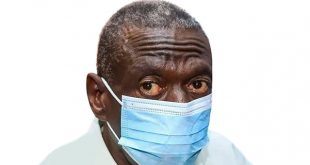
By Ronald Musoke
Frustration as `top Uganda government officials’ are implicated in trafficking poached elephant tusks
In the last two years, about 12 tonnes of ivory from poached elephants has been seized in the Kenyan capital, Nairobi; and all of it came from Uganda. John Okot Emitchell, the field officer for the Nairobi-based Lusaka Agreement Task Force (LATF), which coordinates cooperative enforcement operations directed at illegal trade in wild fauna and flora in East and Central Africa, revealed this on Oct.16 at a meeting of members of Uganda’s top security organs and conservationists. And he had more bad news for Uganda.
Some of the communication shows high ranking government officials involved,” he said, adding that LATF has sought the intervention of President Yoweri Museveni to apprehend the high-ranking officials.
He did not say what the response from the President has been but the Uganda Wildlife Authority (UWA) Executive Director, Dr. Andrew Seguya, is familiar with the operations of ivory traffickers. He told the meeting that illegal ivory buyers, who are mainly West African nationals, have recently relocated to Kampala because of its porous borders, weak laws and instability in the Democratic Republic of Congo, the Central African Republic, and South Sudan. He said Uganda is being used as one the most favoured routes to ship out ivory to South East Asian destinations.

UWA officers argued that corruption tendencies amongst some enforcement and customs officers, as well as some clearing companies has perpetuated the crime in Uganda.
He told the symposium that the traffickers purchase ivory in small quantities over months, and aggregate it before shipping it to the Kenyan port of Mombasa disguised as genuine merchandise. Over 100 members of Uganda’s top security organs and conservationists met in the Gardenia Hall at Imperial Royale Hotel in Kampala to brainstorm and hopefully fix the growing threat that elephant poaching has become.
Uganda is listed among the so-called ‘Gang of 8’— countries that are heavily involved in illicit ivory trade. Others are China, Kenya, Thailand, Malaysia, Vietnam, the Philippines, and Tanzania. In March last year, during the 16th Convention on International Trade in Endangered Species (CITES) conference in Bangkok, members asked these countries to commit to addressing the poaching crisis. They were to draw up action plans, timelines, and milestones of curbing ivory trade during the Bangkok CITES COP. The UWA and the World Wildlife Fund for Nature (WWF) joined hands to raise awareness about illegal wildlife trade and solicit support from Uganda’s security organs to curb it.
David Duli, the World Wildlife for Nature (WWF) country director, expressed the fear of most of the conservationists, tour operators and academics at the symposium when he spoke with both desperation and urgency about elephants being wiped out unless something major is done to prevent it.
“We might be winning a few battles here and there but we are losing the war,” he said.
Earlier, officials of the Uganda Wildlife Authority (UWA) had sought to allay the fears. They said poaching exists in Uganda’s conservation areas but “it is on subsistence and not commercial level”.
Elephant numbers improve
John Makombo, UWA’s director of conservation pointed at figures indicating a rebound in the population of the jumbos over a ten-year period, from an estimated 2400 to about 5000. Although impressive, that is far below the 1960s figures when Uganda had as many as 30,000 elephants roaming in the three original parks of Queen Elizabeth, Murchison Falls and Kidepo Valley.
The good news from UWA is tempered by the gruesome news from elsewhere on the African continent where poaching has clearly been rising sharply in recent years. The threat to the elephants and rhinos; two of the iconic `big five’ that most tourists visit the continent to see, has attracted most attention. Makombo says, basing on DNA tests UWA had done on the intercepted tusks, most come from both forest and savannah elephants, brought all the way from West and southern Africa and exported through Uganda.
He says most are from Nigeria. Small amounts are exported through Cameroon, Gabon and Congo while the big sales go through Kenya, Ethiopia, Tanzania and South Africa. Still Uganda is one of the safest transit routes of this illicit ivory.
Seguya said that despite the improvement in elephant numbers in Uganda, UWA officials remain vigilant as poaching in the neighbouring countries has gone up. According to Bloodyivory.org, another organisation working to stop trade in ivory, there were an estimated 1.3 million African elephants 35 years ago. But a decade later, widespread poaching had reduced that figure by more than half.
In the 1980s, during the so-called ‘Ivory Wars’ it is estimated that at least 700,000 elephants were killed across Africa by hunters and poachers.
The global community in 1989, during the CITES conference in Lausanne, Switzerland, voted to ban all trade in elephant ivory.
By this time, the elephant population had gone down by 80% and only about 600,000 African elephants remained. The ban led to a slow rise in elephant populations as the ivory market slumped.
But a decade later, pressure from countries like Botswana, Namibia, and South Africa forced CITES to down-list the status of elephants so these states could sell up to 49,000 kilogrammes of stockpiled ivory on the open market.
In 2002, a further one off-sale was approved, which finally took place in 2008 – and resulted in 105,000kg of ivory being shipped to China and Japan.
These three African countries argued that their ivory comes from elephants that have died naturally or was seized from illegal poachers. The idea was that by allowing a few legal sales, pressure for ivory would diminish, mostly in the affluent South-East Asian nations and therefore reduce elephant poaching.
However, as earlier feared by the conservationists, there was a spike in elephant killings as poachers used the opportunity to mix new ivory with the old stock. The vice spread from southern Africa, northwards with Tanzania hit hardest. The percentage of elephant mortality attributed to poaching in that country rose from 22% in 2003 to 62% in 2009. Today, Tanzania has lost over 68% of elephants.
Makombo says Uganda too has relatively registered high poaching deaths.In the last 10 years, the UWA official says, 234 elephants have succumbed to the poachers’ bullets and machetes. In 2011 alone, up to 56 elephants were killed.
In July 2012, CITES recognised that elephant poaching had reached ‘unsustainable’ levels, not only in small unprotected populations but also among larger populations traditionally regarded as safe.
Buoyed by the insatiable demand for ivory from affluent South East Asian states of China, Thailand and Vietnam, the price of ivory has skyrocketed from US $5/kg in 1989 to a wholesale price of US $2,100/kg in China in 2014. Retail prices are said to be much higher. This has only served to fuel the vice across the continent.
According to CITES, from 2009 to June 2014, criminal networks trafficked as much as 170,000 kilogrammes of ivory implying that the number of elephants that are being killed far exceeds the number being born.
Tough action needed
During the Kampala symposium, conservationists kept on talking about the money involved in poaching being very big and therefore new measures to rein in the poachers must be devised quickly.
Most people at the symposium agreed that as Uganda’s Wildlife Act gets revised in the coming months, legislators should take the example of Kenya where the Wildlife Conservation and Management Bill, 2013 is being debated.
Duli said Uganda’s law should provide strong deterrent measures because the current law is not punitive enough.
“At the moment, if you’re caught with ivory, you could pay about one million shillings yet (a 10kg tusk) ivory goes for between US$ 10-20, 000 (approx. Shs54 million),” he said. The Kenyan anti-poaching law provides for a life sentence for those convicted of dealing in illegal wildlife trade.
This, Duli said, is the way to go. The Kenyan law provides for mechanisms for community involvement in wildlife management and it also provides for mechanisms of compensation for losses resulting from human wildlife conflicts to communities.
Tanzania too, the participants said, could offer Uganda a lesson on how to decisively deal with ivory traffickers.
They pointed out the case of Yu Bo, a Chinese national who was early this year arrested at the Tanzanian port of Dar es Salaam for illegal possession of 81 elephant tusks weighing 303 kg worth TShs 978m (Ushs 1.4 billion). When Yu, 45, was charged in court, he pleaded ‘guilty’ and the sentence on March 19 was as swift as it was severe. He had to choose between paying a hefty fine of TShs 9.7 billion (about US$6.5m) or serve 20 years in prison. He could not pay his way out and is serving the jail term. Devota Kisoka, the magistrate who sentenced him said she imposed the severe sentence “to serve as a lesson to others who might be tempted to engage in poaching or act as accomplices to the crime”.
Patrick Mugoya, the Permanent Secretary at the Ministry of Tourism, Wildlife and Antiquities, said Uganda was already implementing the Ivory Action Plan demanded by the Bangkok CITES-COP and cited the new Uganda Wildlife Policy 2014 which was recently passed by cabinet as a sign that Uganda is serious about tackling illegal trade in endangered species.
Seguya wants the government to quickly install heavy-grade scanners at all the entry points, including Entebbe International Airport.This will enable scanning of containers without necessarily opening them, he said.
Seguya said UWA was also considering ways to encourage more community participation in protecting animals in conservation areas. He said the 20% of all gate collections from national parks meant to go back to communities adjacent to the protected areas would be ring-fenced for issues like compensation for damage caused by animals from the conservation areas, provision of alternative livelihoods, safe water, schools, and hospitals. He said, although UWA recently paid out about Shs 2.6 billion to six districts neighbouring Murchison Falls Park, the local governments spent the money on other areas they see as priorities.
David Musingo, the Manager Wildlife Clubs of Uganda, suggested an even fresher approach; `shock therapy’ for the ivory consumers.
According to Musingo who has just returned from China, most buyers of the famed beautiful jewelry and other products referred to as ‘white gold’, are ignorant of the criminality, torture, and brutality involved in getting the ivory they treasure so much.He said when he shared with them the plight of the African elephants, most of them were shocked to find out that to get just 10kgs of ivory, a 50-year old elephant weighing about 5000kg had to be butchered. He said China, where most of the ivory goes, is willing to collaborate with Uganda to end the illegal trade.
 The Independent Uganda: You get the Truth we Pay the Price
The Independent Uganda: You get the Truth we Pay the Price


